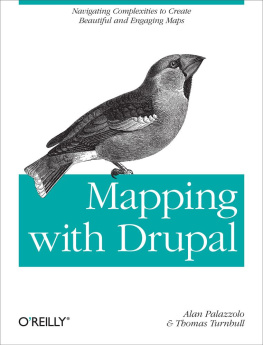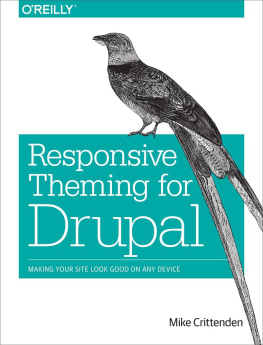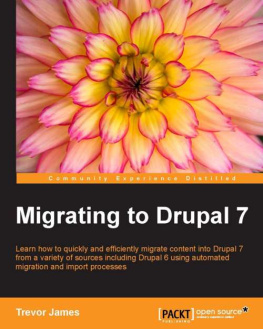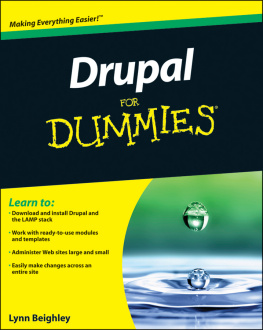Audience
This book is intended for people building Drupal websites who would like to visualize their content on a map. Maps are powerful and can tell a rich story. A map is instantly readable, but at the same time almost infinitely revealing. With the rise of maps on the Internet and now on cell phones, the way we navigate our lives has changed. Recognizing this, more web developers are integrating location into websites and applications .
Drupal is a versatile content management system, and because of that, it has been extended through many contributed modules to support mapping. Drupal is not primarily a mapping platform, however, so mapping in Drupal can be tricky. But because Drupal is so extendable, mapping in Drupal can be adapted to your specific needs. This book will help you navigate these complexities to create beautiful and engaging maps.
By the end of this book, you will be able to create a website with a map that automatically centers on the users location. The map will include events and local groups that have been added through intuitive interfaces. Rather than using one of the maps from Google or Bing that have become so familiar, perhaps you will create a custom base map that fits the color scheme of your site. And rather than some pink pins, the events and local groups shown on your map will be marked with custom icons created for your site.
We assume you know how to install Drupal, install contributed modules, and enable themes; maybe you have already built a site that is used publicly. If you have not done these things or feel you do not have a great grasp on Drupal, dont stop reading this book just yet. Read over the first few chapters to get a feel for what is possible, take that enthusiasm and read over some other tutorials or books to learn the basics of site building with Drupal, and then come back. There are some great titles to get you started working with Drupal, some of which are listed in . But dont worry, we will try our best to not assume too much.
Later in this book, we will look at writing code to extend existing mapping modules. When we get there, we will assume you know a little about writing Drupal modules; at a minimum you should understand how to create a simple custom module for a site and be familiar with Drupal hooks. If you are new to writing Drupal modules, there are some books listed in that will help you get up to speed developing for Drupal.
Drupal and Mapping Glossary
Drupal and web mapping come with specific terminology that is helpful when talking about these technologies, like modules, nodes, map tiles, and WKT. If you are new to Drupal or web mapping and these terms are not familiar, take a moment to read .
Drupal 7 Modules
This book is written for Drupal 7, which was released in January 2011. Most of what we shall discuss will use contributed modules found on .
Conventions Used in This Book
The following typographical conventions are used in this book:
Italic
Indicates new terms, URLs, email addresses, filenames, and file extensions.
Constant widthUsed for program listings, as well as within paragraphs to refer to program elements such as variable or function names, databases, data types, environment variables, statements, and keywords.
Constant width boldShows commands or other text that should be typed literally by the user.
Constant width italicShows text that should be replaced with user-supplied values or by values determined by context.
Tip
This icon signifies a tip, suggestion, or general note.
Caution
This icon indicates a warning or caution.
Using Code Examples
This book is here to help you get your job done. In general, you may use the code in this book in your programs and documentation. You do not need to contact us for permission unless youre reproducing a significant portion of the code. For example, writing a program that uses several chunks of code from this book does not require permission. Selling or distributing a CD-ROM of examples from OReilly books does require permission. Answering a question by citing this book and quoting example code does not require permission. Incorporating a significant amount of example code from this book into your products documentation does require permission.
We appreciate, but do not require, attribution. An attribution usually includes the title, author, publisher, and ISBN. For example: Mapping with Drupal by Alan Palazzolo and Thomas Turnbull (OReilly). Copyright 2012 Alan Palazzolo and Thomas Turnbull, 978-1-449-30894-0.
If you feel your use of code examples falls outside fair use or the permission given above, feel free to contact us at .
Safari Books Online
Note
Safari Books Online is an on-demand digital library that lets you easily search over 7,500 technology and creative reference books and videos to find the answers you need quickly.
With a subscription, you can read any page and watch any video from our library online. Read books on your cell phone and mobile devices. Access new titles before they are available for print, and get exclusive access to manuscripts in development and post feedback for the authors. Copy and paste code samples, organize your favorites, download chapters, bookmark key sections, create notes, print out pages, and benefit from tons of other time-saving features.
OReilly Media has uploaded this book to the Safari Books Online service. To have full digital access to this book and others on similar topics from OReilly and other publishers, sign up for free at http://my.safaribooksonline.com.
How to Contact Us
Please address comments and questions concerning this book to the publisher:
| OReilly Media, Inc. |
| 1005 Gravenstein Highway North |
| Sebastopol, CA 95472 |
| 800-998-9938 (in the United States or Canada) |
| 707-829-0515 (international or local) |
| 707-829-0104 (fax) |










